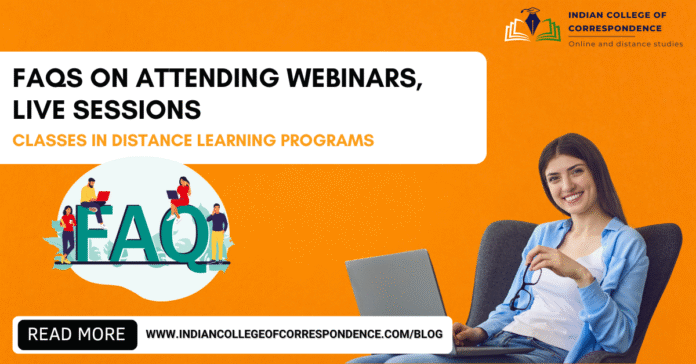Distance learning programs, which provide students all over the world with unmatched flexibility and accessibility, have been a disruptive force in education in recent years. The ways that students and teachers can communicate have greatly increased as a result of technological improvements. These days, contact classes, webinars, and live sessions are essential for bridging the gap between traditional and remote learning.
However, for many students new to distance learning, these formats can raise several questions. How do you attend a webinar? What is the difference between a live session and a contact class? Are they mandatory? This blog covers the most frequently asked questions regarding attending webinars, live sessions, and contact classes in Distance Learning Programs, helping you prepare, participate effectively, and make the most of your learning journey.
1. What Are Webinars in Distance Learning Programs?
Webinars are virtual seminars conducted over the internet where a host (usually a professor or guest expert) shares knowledge on a specific topic. These are interactive and may include Q&A sessions, presentations, or workshops.
Key Features:
- Conducted in real-time or recorded for later viewing.
- Accessible via platforms like Zoom, Google Meet, or Microsoft Teams.
- Useful for delivering subject overviews, career guidance, exam prep, and guest lectures.
2. How Do I Join a Webinar?
To join a webinar in your Distance Learning Program, you typically:
- Receive a webinar link and joining instructions via email or learning portal.
- Log in at the scheduled time using your credentials.
- Ensure stable internet connectivity, a functioning microphone, and headphones.
Tips for Joining:
- Check the time zone and convert it to your local time.
- Join 5-10 minutes early to resolve any tech issues.
- Mute your mic unless you’re speaking to minimize background noise.
3. Are Webinars Mandatory in Distance Learning?
Not all the time. While some colleges treat webinars as mandatory elements of your course, others identify them as optional learning additions. Always consult your course handbook or get in touch with your academic coordinator.
4. What Are Live Sessions?
Live sessions are scheduled, real-time classes that resemble traditional classrooms. These are generally more structured and curriculum-based than webinars.
Common Formats:
- Live lectures or tutorials.
- Interactive Q&A or doubt-clearing sessions.
- Collaborative activities with peers.
Live sessions foster real-time interaction, which enhances understanding and builds a sense of community among distance learners.
5. What If I Miss a Live Session?
Most Distance Learning Programs record live sessions and upload them to the student portal or LMS (Learning Management System). If you miss a class, you can usually:
- Watch the recorded session later.
- Review the shared presentation material or notes.
- Connect with your professor during office hours or email.
However, consistent absence from live sessions may affect participation marks, depending on your university’s policy.
6. How Should I Prepare for a Live Session?
Preparing ahead helps you get the most out of live sessions. Here’s how:
- Review the syllabus/topic in advance.
- List your doubts or questions to ask during the session.
- Complete any required readings or assignments beforehand.
- Log in early and ensure your devices are fully charged.
7. What Are Contact Classes?
Contact Classes are offline, in-person classes held at designated centers. These are periodic and give students a chance to meet faculty and peers physically.
Typically Involve:
- Doubt clearing and practical demonstrations.
- Lab sessions for science/technical courses.
- Counseling and peer-group discussions.
- Exam form submission and document verification.
These classes offer a taste of traditional education within the flexibility of distance learning.
8. Are Contact Classes Compulsory?
This depends on your university and the program you are enrolled in. In many cases:
- For practical/lab-based subjects, attendance in contact classes is mandatory.
- For theory-based courses, they are optional but highly recommended.
Attending contact classes improves academic performance, helps in exam preparation, and boosts motivation through face-to-face interaction.
9. How Frequently Are Contact Classes Conducted?
Frequency varies:
- Typically held once or twice per semester.
- Last for 2–7 days depending on the course structure.
- Often scheduled on weekends or during holidays to accommodate working professionals.
Your university will notify you well in advance regarding the dates, venue, and session plan.
10. Can I Attend Contact Classes at a Different Location?
Some universities allow students to choose from multiple centers. However:
- Seats at certain centers may be limited.
- You must apply or request a change in advance.
- Approval is at the discretion of the academic department.
Always check your institution’s policy before making travel plans.
11. What If I Can’t Attend Contact Classes?
In cases of valid reasons (health issues, travel restrictions, emergencies), you should:
- Inform your academic counselor or university support team.
- Check if recordings or study materials are provided.
- Request alternate arrangements (e.g., attending online if hybrid mode is available).
Failure to attend may affect exam eligibility or internal assessments in some universities.
12. Do Webinars, Live Sessions, or Contact Classes Offer Attendance Certificates?
Some Distance Learning Programs provide:
- Participation certificates for attending special webinars (especially those with guest speakers or industry experts).
- Attendance scores for live sessions or contact classes, which may impact your final grade.
Keep track of your attendance and certificates—they add value to your academic profile and résumé.
13. What Technical Requirements Do I Need?
To attend virtual sessions, you’ll need:
- A smartphone, tablet, laptop, or desktop.
- Reliable internet (minimum 1 Mbps speed).
- Headphones and webcam (optional, but improves interaction).
- Installed software like Zoom, Microsoft Teams, or Google Meet.
Contact classes may require:
- Your student ID card, notebooks, course textbooks, and any practical tools specified by your course.
14. How Do I Interact During a Webinar or Live Session?
Make your presence known respectfully:
- Use the “Raise Hand” feature to ask questions.
- Use chat to post doubts or feedback.
- Unmute yourself only when permitted.
- Keep your queries concise and topic-related.
Engaging in discussions makes you more visible to instructors and peers, building rapport.
15. What Are the Benefits of Attending These Sessions?
Attending webinars, live classes, and contact sessions enhances your:
- Understanding of complex topics through real-time explanations.
- Communication skills through interaction.
- Networking with peers and industry professionals.
- Academic performance through continuous guidance.
- Confidence by staying in tune with your course progress.
16. Are There Any Costs Involved?
Most sessions (especially webinars and live classes) are included in your course fee. However:
- Some premium webinars may have a nominal fee.
- You may need to cover your travel or accommodation expenses for contact classes.
Check with your academic institution for a detailed cost breakdown.
17. What Happens in Hybrid Classes?
Hybrid learning is a blend of online and offline classes. You may:
- Attend lectures online while doing practicals in contact centers.
- Choose to attend either in-person or via live stream.
- Experience more flexible attendance options.
Hybrid models are increasingly popular in Distance Learning Programs as they cater to diverse student needs.
18. Can Working Professionals Manage These Sessions?
Absolutely. In fact, many Distance Learning Programs are designed with working professionals in mind. Features include:
- Weekend or evening live sessions.
- Flexible webinar schedules.
- Recorded lectures for later viewing.
- Contact classes on public holidays.
Proper planning and employer support can make balancing work and study seamless.
19. Where Can I Find the Schedule for Upcoming Sessions?
You can find your academic schedule in:
- Your student portal or LMS dashboard.
- Emails and SMS notifications from your university.
- WhatsApp groups or Telegram channels created by your batch.
Stay updated by regularly checking your communication channels.
20. How Can I Get Personalized Help for My Program?
To get tailored guidance about your sessions, academic plan, or career goals, it’s best to connect with an educational consultancy that understands distance learning deeply.
Why Choose Indian College of Correspondence?
If you’re feeling overwhelmed with schedules, attendance, or program selection in distance learning, Indian College of Correspondence can help.
Here’s Why:
- Expert Counseling: Get one-on-one support to choose the right university and program.
- Academic Support: Clarification on session formats, exam schedules, and documentation.
- Placement Assistance: Guidance on job prospects after your course.
- Trusted Partnerships: Tie-ups with reputed universities offering UGC-approved Distance Learning Programs.
Whether you’re a working professional or a fresh graduate, Indian College of Correspondence simplifies your journey with reliable, transparent, and expert educational support.
👉 Get in touch with Indian College of Correspondence today and make your distance learning journey smooth, structured, and successful!
Final Words
Webinars, live sessions, and contact classes are essential touchpoints that keep students engaged, motivated, and on track in their Distance Learning Programs. Knowing how to attend, interact, and benefit from them can make a significant difference in your academic success. Don’t skip them—embrace them!
For personalized advice, program selection, and student support, connect with Indian College of Correspondence—your trusted partner in distance education.



